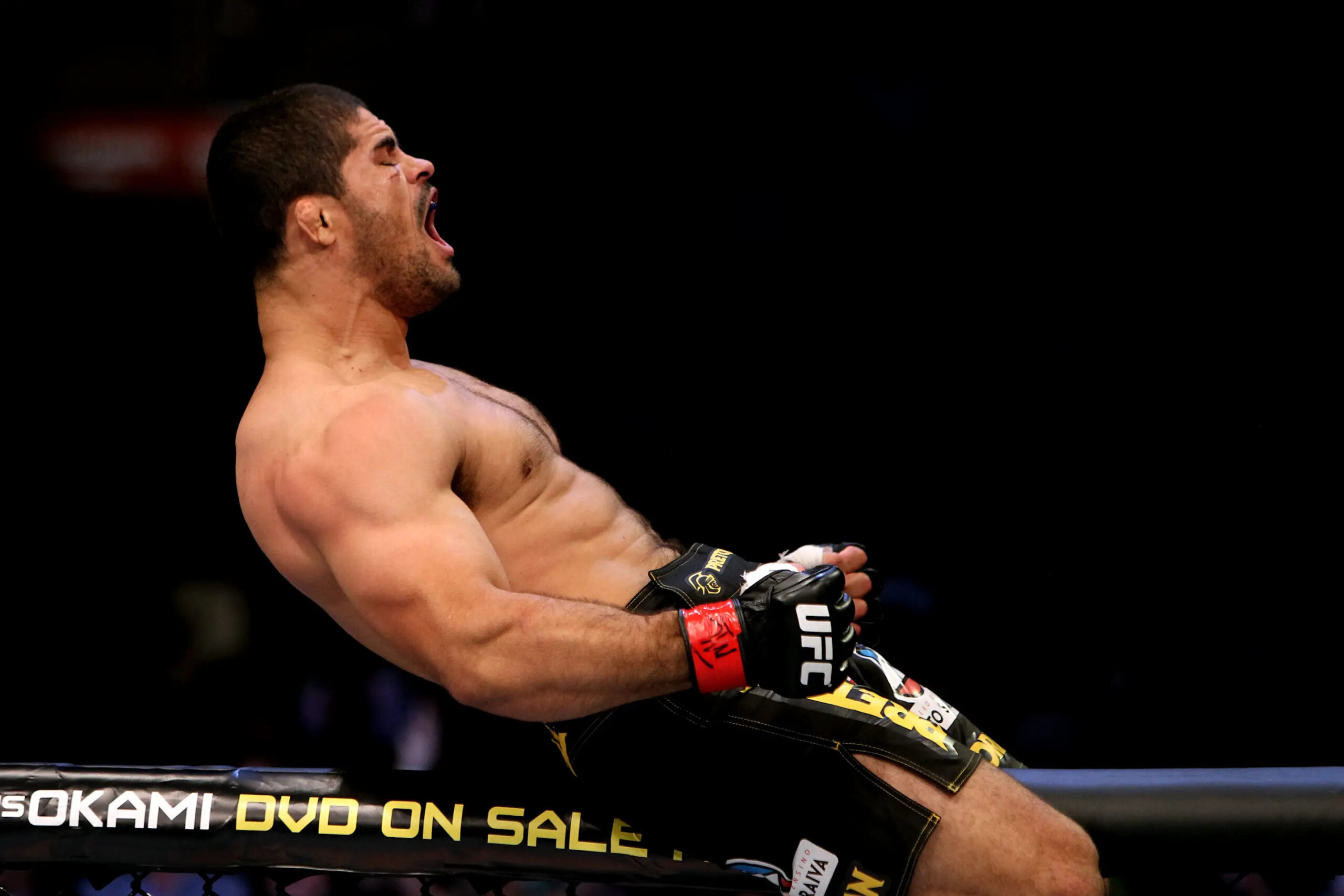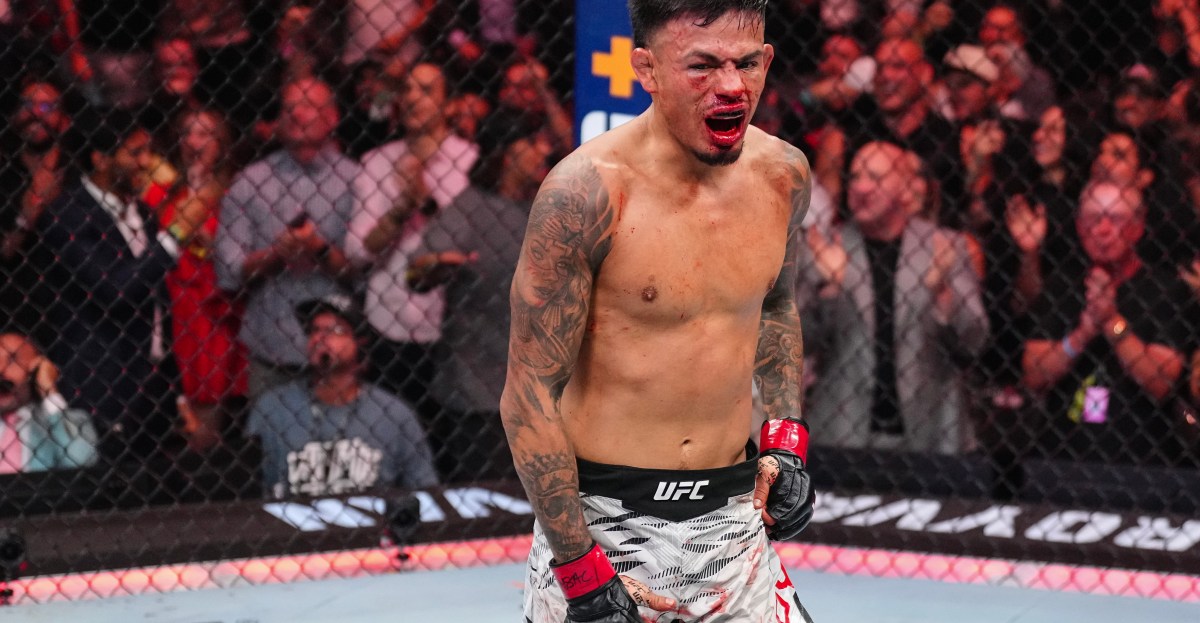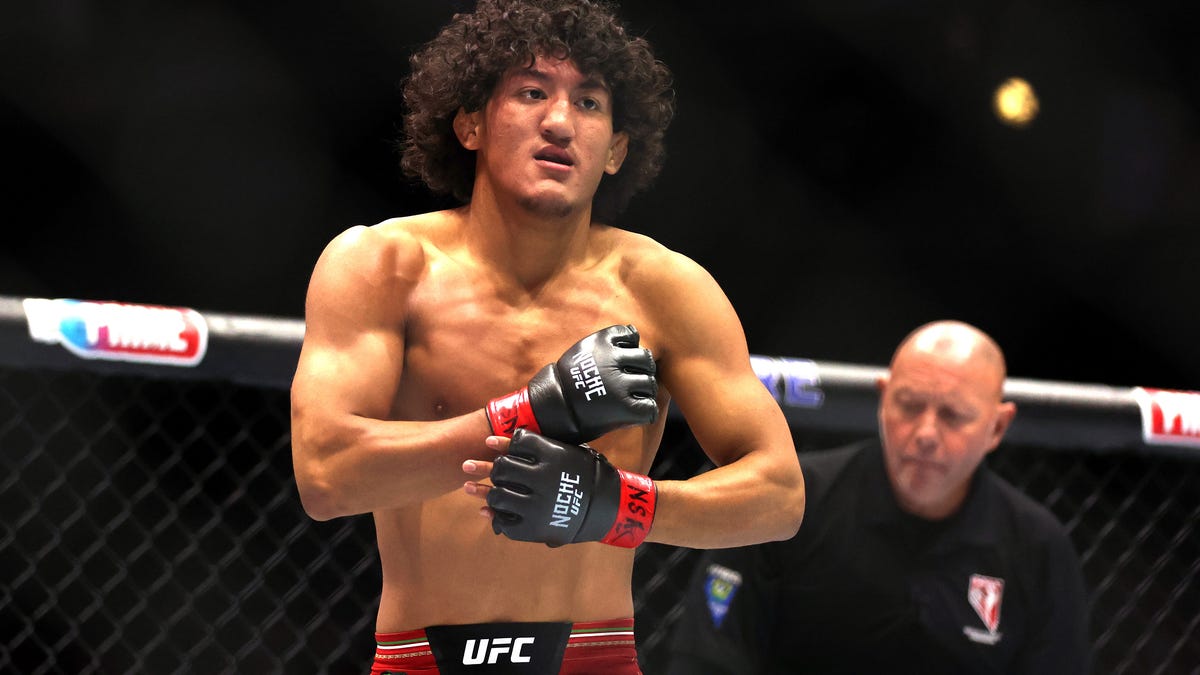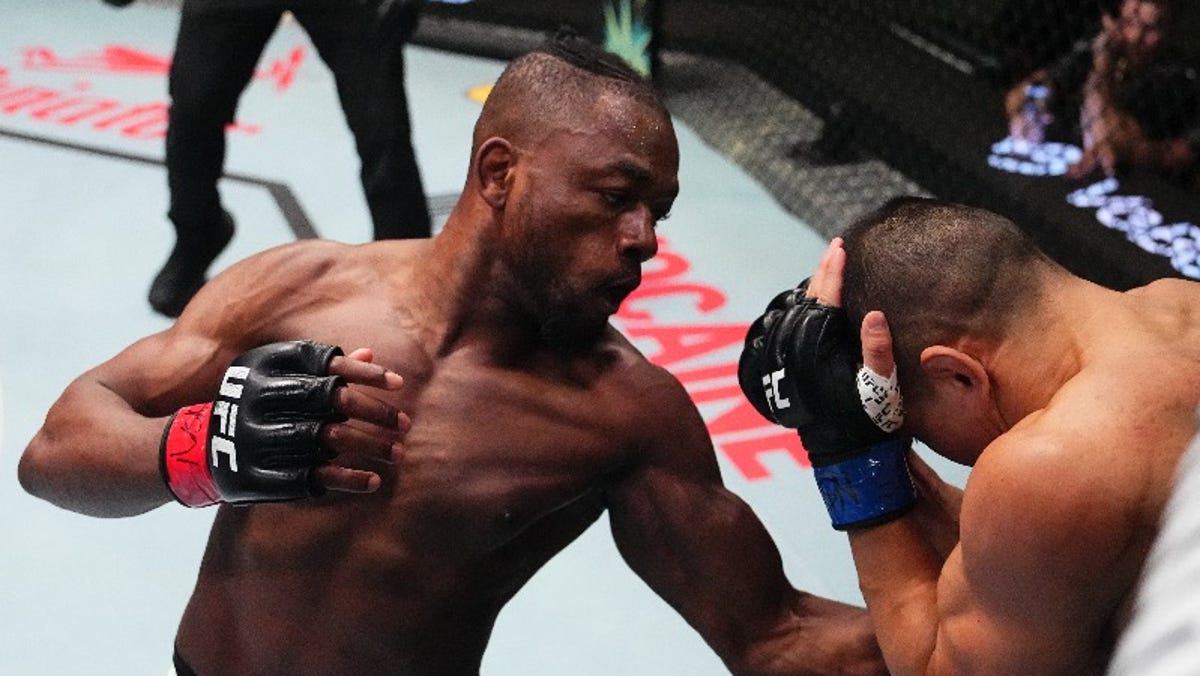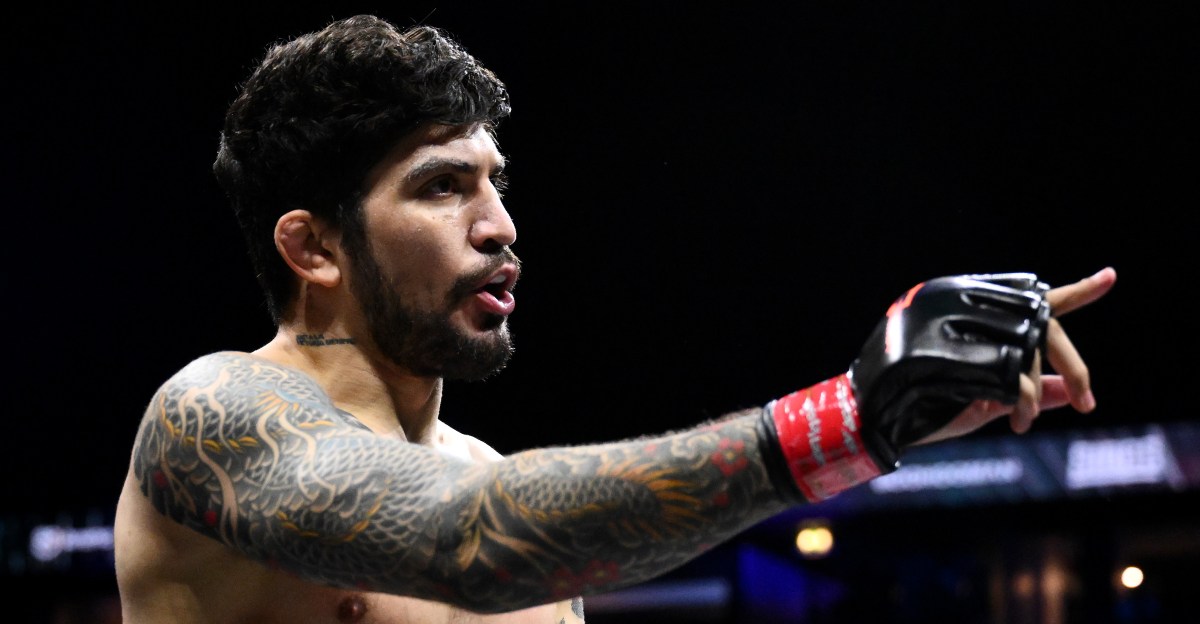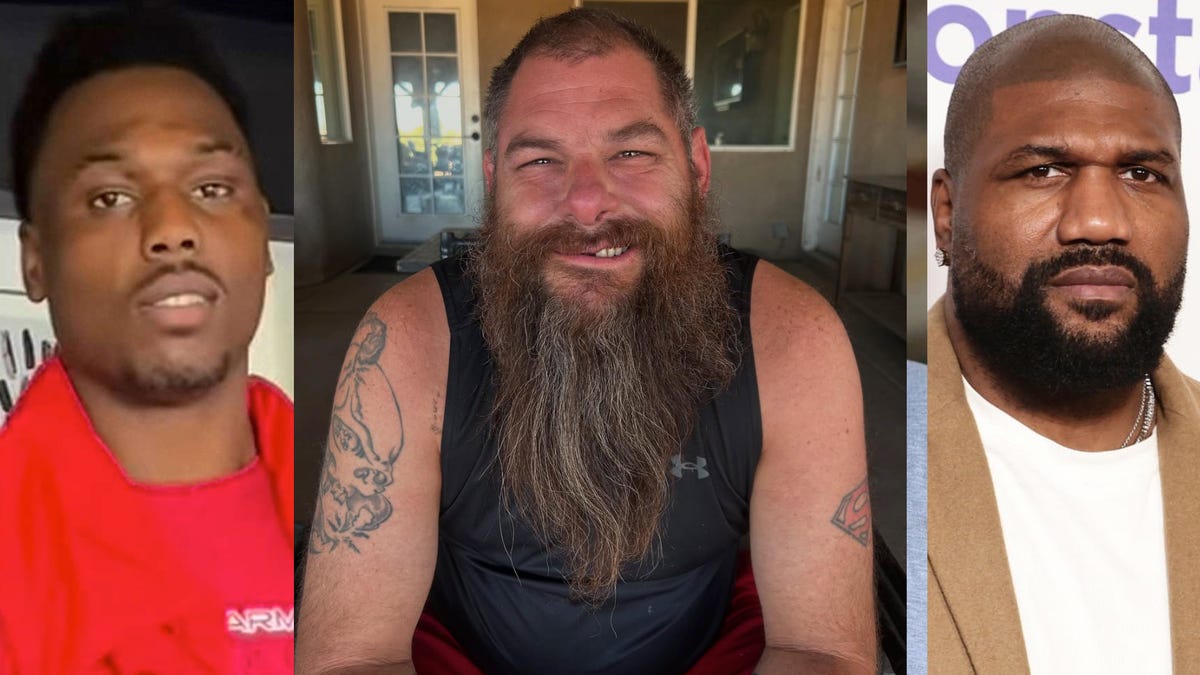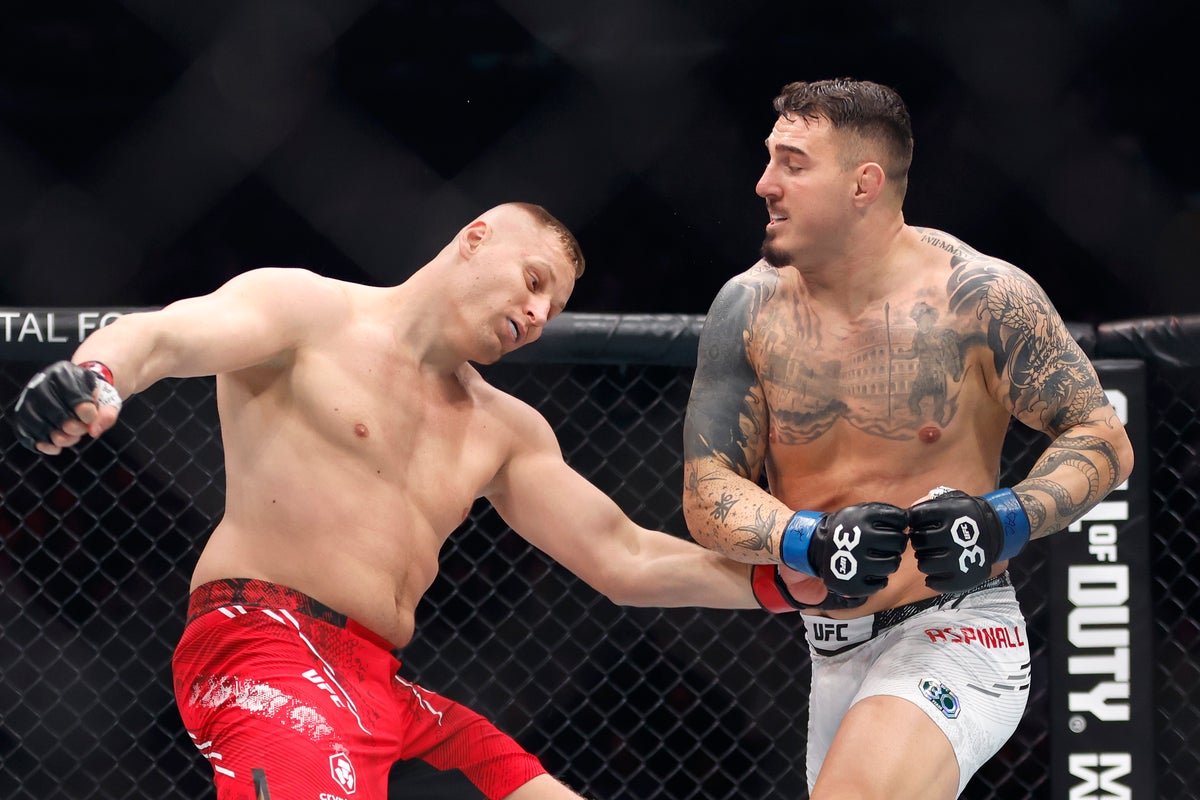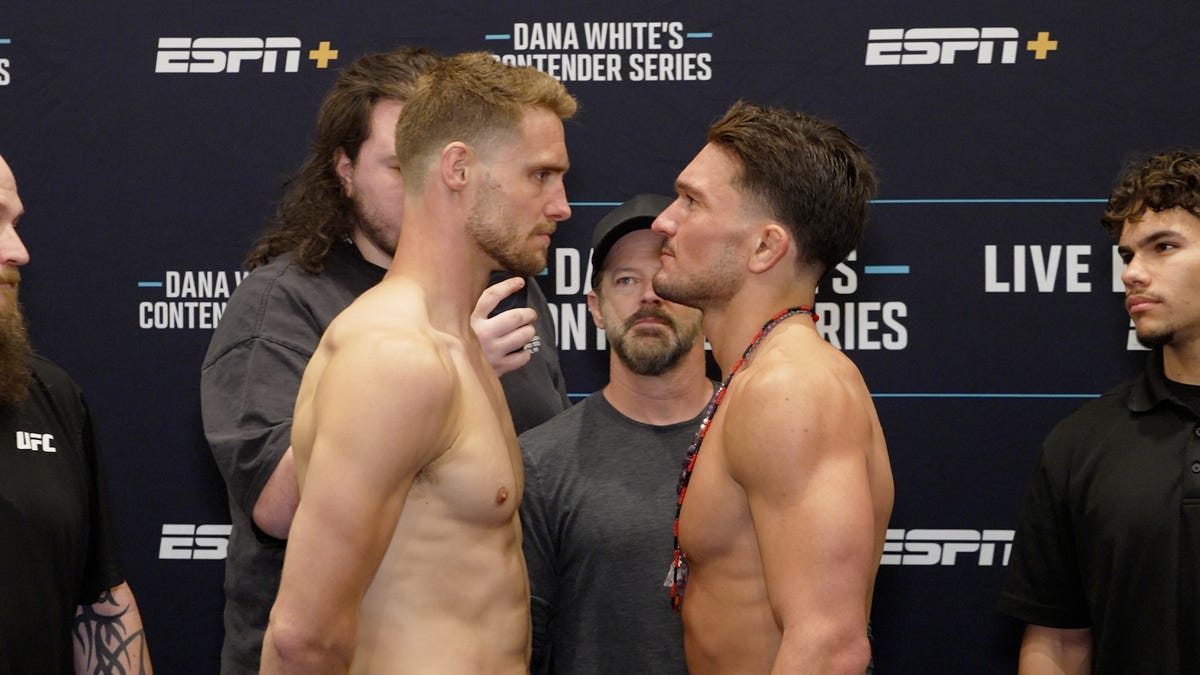The name Rousimar Palhares will go in one ear and out the other of most who entered MMA circles this decade. But those who watched limb ripped from limb during Palhares’ prime years know he left a mark. The controversial Brazilian was a specialist of the highest degree — a submission artist, but not the kind with an extensive bag of tricks.
Palhares mostly knew one trick, but it was a good one. It delivered results. It’s why all his opponents, whether they won or lost, never forgot him.
Advertisement
Advertisement
Advertisement
Advertisement
There is a vast difference between modern MMA and the sport’s origins as 1990s “human cockfighting,” and Palhares competed in the UFC well after rules were established. He just happened to fight like there weren’t any. In fact, you could say the very idea of rules was a thorn in the infamous leg-lock master’s side. And in the end, he paid the ultimate price.
Rousimar Palhares was once one of MMA’s most feared submissions artists — in more ways than one.
(Josh Hedges via Getty Images)
It was 9:04 p.m. when I reached out to 14-fight UFC veteran Mike Pierce to speak about his experience against Palhares. He responded at 9:06 p.m. To say he was eager to express himself is an understatement.
Pierce, 44, played a pivotal role in the Palhares story. He was the notorious fighter’s final UFC opponent — a 2013 bout that doubled as the second-to-last fight of Pierce’s own career.
Advertisement
Advertisement
Advertisement
Advertisement
Pierce was red-hot at the time, seeking his fifth straight win. According to both men, a welterweight title shot awaited the winner against whoever was victorious in Georges St-Pierre’s championship defense against Johny Hendricks at UFC 167.
But the bout ended before it even got started. Thirty one seconds for Pierce that lingers to this day.
“Yeah, I lost, and that sucks in its own respect,” he says. “But I hate that he tried robbing some of my quality of life.
“Whenever I got involved with this sport, I was like, ‘I don’t want to be one of these guys that has a permanent injury or some sort of cognitive disability at the end of this. I want to be able to get in here, do what I want to do, and get out and have a good, fun quality of life afterward for my kids, my kids’ kids.’ That was always the goal. I think I’ve succeeded with most of that — with the exception of Palhares.”
Advertisement
Advertisement
Advertisement
Advertisement
There weren’t any secrets about the dangers of fighting Palhares by the time Pierce accepted the challenge for a UFC Fight Night event in Brazil. Former UFC middleweight champion and jiu-jitsu ace Murilo Bustamante had trained Palhares to black belt status before he even arrived in the UFC, and once Palhares was in the promotion, it was as if Bustamante had unleashed his own personal Tasmanian devil upon the rest of the roster.
Because, you see, “Toquinho” — a nickname that translates to “Little Tree Stump” — was a 33-year-old wrecking ball. Eight of his 14 wins before Pierce had already come with leg lock submissions that left several victims injured. Palhares’ grip was like getting caught in a meat grinder which contorted a leg to the point of no return — and often enough, beyond that point.
Although he was physically built like an overinflated create-a-character in a “Street Fighter” video game, Palhares barreled through the sport with zero knockouts to his name. His threat came solely in the grappling department, which more often than not, was enough.
So Pierce’s game plan was simple, and essentially the same as every other Palhares opponent — avoid the leg trap and your chances of coming out safe would be high.
Advertisement
Advertisement
Advertisement
Advertisement
That was, of course, much easier said than done.
The tap came at the 28-second mark of the fight. An excruciatingly long, full three seconds later, Palhares released Pierce’s leg, only after referee Keith Peterson made frantic contact to save the screaming American. The moment was brutal — and inexcusable — considering how many taps Pierce was forced to give.
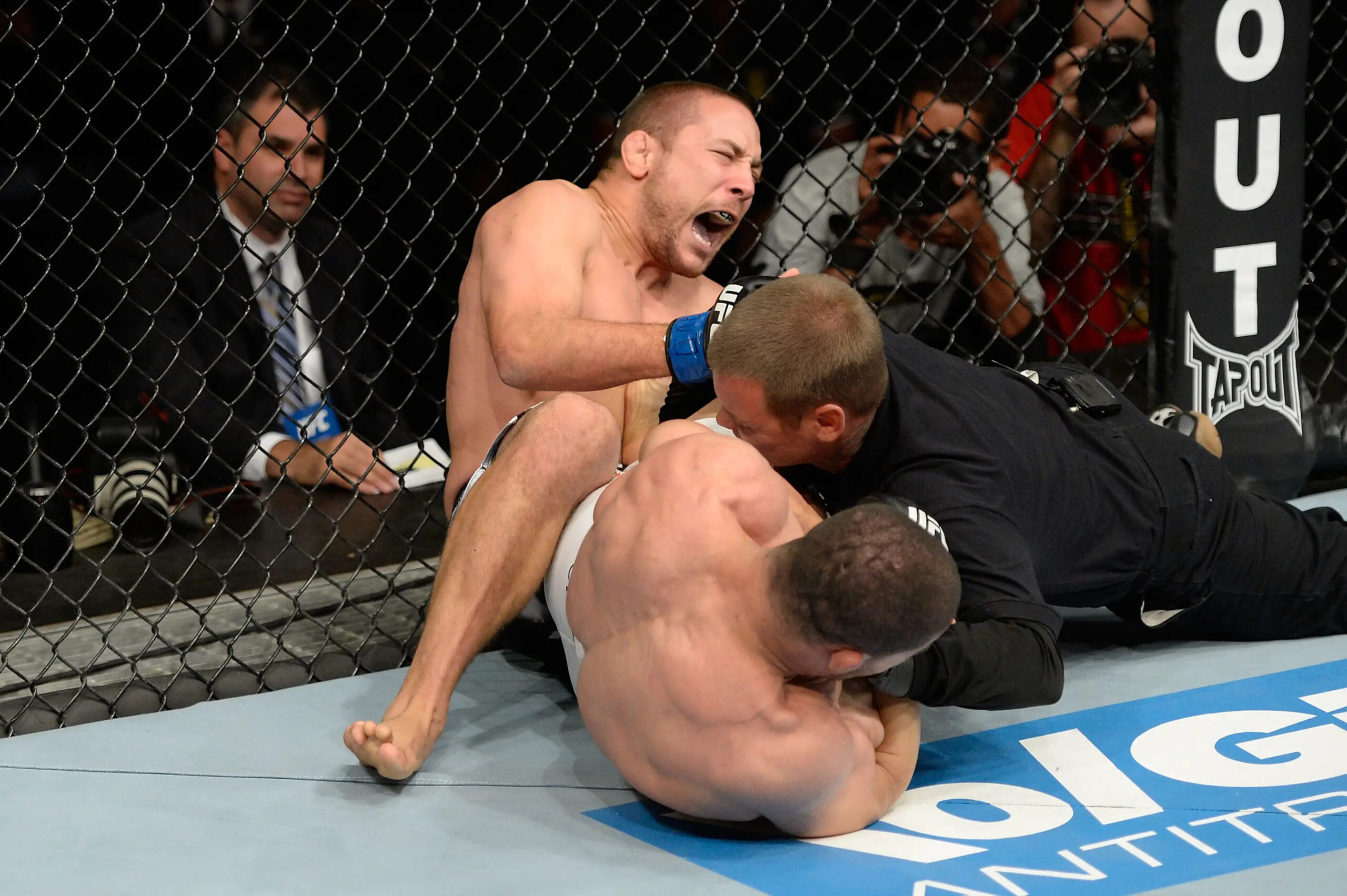
Oct. 9, 2013: Mike Pierce screams while getting submitted by Rousimar Palhares in their UFC welterweight in Sao Paulo, Brazil.
(Jeff Bottari via Getty Images)
It wasn’t Palhares first prolonged submission. It wasn’t even his first in the UFC. By the time Palhares met Pierce, his reputation had been built beyond simply being the most dangerous submission artist in the sport: He was the guy who would injure opponents once they were stuck in submissions.
Advertisement
Advertisement
Advertisement
Advertisement
Yet if fighting someone with Palhares’ track record was enough to create concern for anyone, in Pierce’s case, he also welcomed Palhares to the 185-pound division fresh off the Brazilian’s suspension for elevated testosterone, which had kept Palhares on the sidelines for nearly a year.
Pierce only ever turned down one fight in his 24-fight career — a one-week’s notice pairing with the future welterweight champion Robbie Lawler, which none could fault him for hesitating to take. But with Palhares, Pierce felt backed into a corner from the moment the Brazilian crossed his radar.
“[It was] two things,” Pierce says. “The reservations were, number one, this guy likes to hold heel hooks and injure people. Then, number two, he’d already tested positive for steroids. I don’t even understand why they give these guys second chances. I guess I understand to a degree — OK, you screw up, there’s some tainted supplements, which do happen on occasion. You get these things off of Amazon or some other third-party vendor that are trying to make a stamp in the industry. It’s still kinda shady, you should know better, and all that stuff. [But] this guy, you could just tell with his physique — he had a long history of it. Hell, even his teammates told me, ‘Yeah, he’s juiced to the gills.’
“So you’re kind of stuck between a rock and a hard place, especially with the UFC. The UFC, you turn fights down, they kind of raise eyebrows and go, ‘OK, this guy’s maybe not a company man, he’s not playing ball,’ and you start getting question marks around that. Especially with the pressure that they can put on you, it’s not a good thing to have hanging over your head.
Advertisement
Advertisement
Advertisement
Advertisement
“I kind of felt like I was in a position where I didn’t have a lot of choice, even though those reservations were clearly legitimate to be concerned about. Push comes to shove, you don’t have a lot of options. You’ve got to take what’s given.”
Pierce was out of action for two years after Palhares mangled his leg. He dropped his return bout against Ryan LaFlare in December 2015 and was released from the UFC one month later.
Yeah, I lost, and that sucks in its own respect. But I hate that he tried robbing some of my quality of life.
Twelve years removed from the bout, Pierce refers to Palhares as “the beginning of the end.” He suffered a meniscus tear and damage to his ACL. His knee never regained stability after the encounter, and he felt that reality in-cage when he battled LaFlare. Pierce essentially fought with one leg and suffered additional damage by continuing his career with that singular fight. He required further surgeries for a torn meniscus and ACL after the LaFlare bout. His knee’s range of motion still isn’t what it used to be, despite the many surgeries and rehab stints over the years.
Pierce never had an opportunity to speak with Palhares after they met in the Octagon. He was put in a lose-lose situation from the start, and admits he knew it, to an extent. When promised the situation with Palhares’ illegal actions would be handled afterward, it didn’t matter. The damage had been done.
Advertisement
Advertisement
Advertisement
Advertisement
“This is a story I don’t know how many times I’ve told, probably only a small handful, but something out of the norm happened directly after the fight,” Pierce says.
“Of course, this fight between me and him was in Brazil, so he had essentially a home-court advantage. I remember being pissed off losing the fight, as anyone would expect right after a loss, but it was just the way in which he did it — it definitely went above and beyond what he needed to do or what he should have done. One of the lawyers from the UFC came down, Mike Mersch, and he was asking me, ‘Hey, I would like your professional opinion about whether or not you felt like he held the submission too long.’
“I just kind of laughed. We’re in Brazil with a Brazilian commission — like, does it even matter? [Mersch] kind of laughed. He’s like, ‘We’ll make them care. But what do you think?’ And I said, ‘Look, I’m not mad that I lost the fight or got caught. That’s part of this game, right? When you get caught, you’re caught. But when you’re tapping, especially with something like that, you need to let go in an appropriate amount of time, because you’re going to do irreparable damage.’
“If you go back and look at the tape, the referee was actually physically pushing him off of my leg because the motherf***er wouldn’t let go. This is insane. Even the ref came back, he’s like, ‘Man, dude, I did everything I could to get him off. He was just not letting go.’ After telling Mike that, obviously [UFC President] Dana [White] and the Brazilian commission, they didn’t want to have to deal with him anymore, which is why he was no longer a contracted fighter for the UFC.”
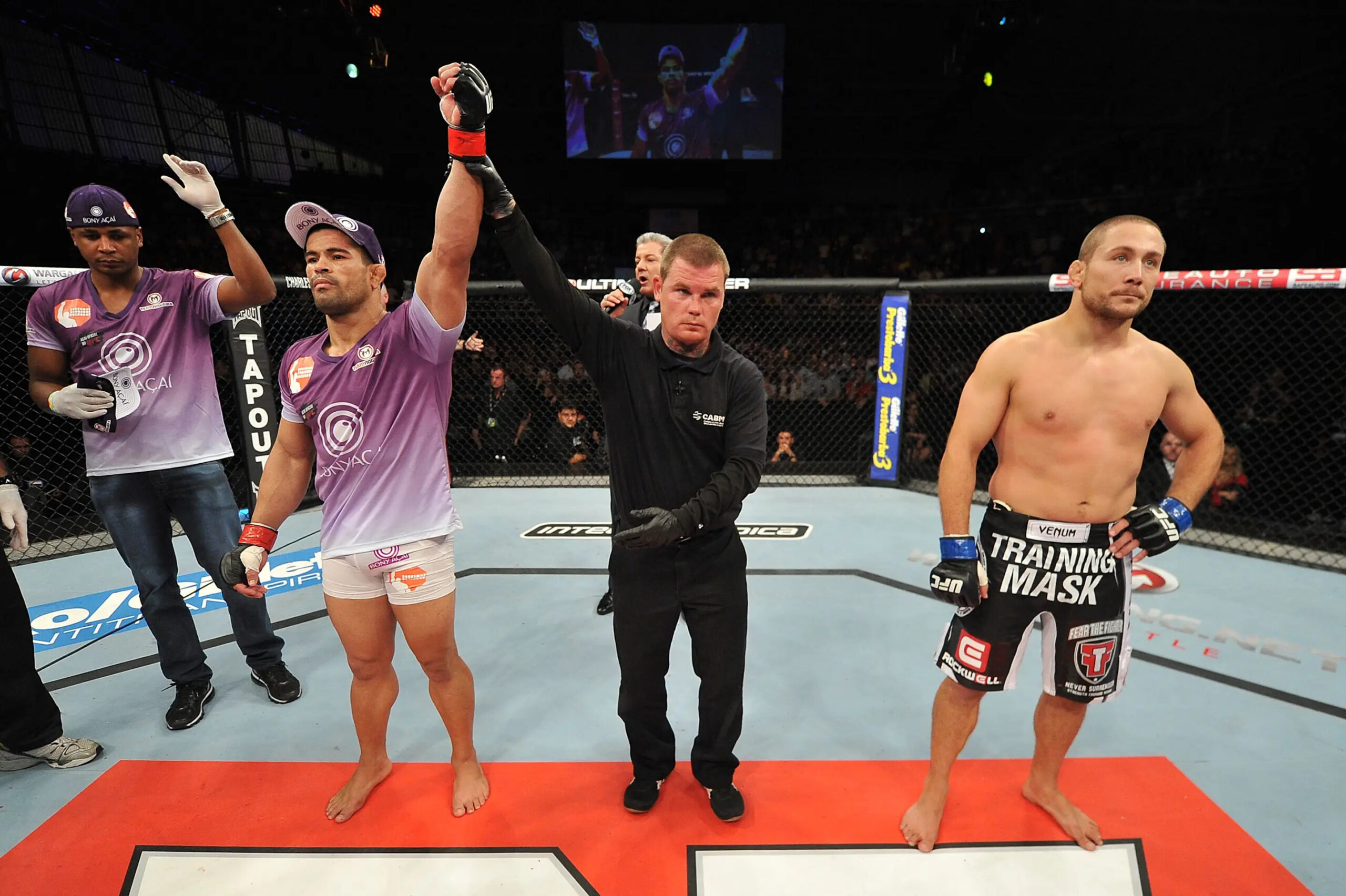
Oct. 9, 2013: Rousimar Palhares celebrates after defeating Mike Pierce in a welterweight bout that left Pierce with injuries that persist to this day.
(Jeff Bottari via Getty Images)
Palhares was neither suspended nor fined after the Pierce fight. Instead, he lost his job in the UFC. White had seen enough. It was one of those rare moments when the UFC boss publicly appeared on FOX Sports Live to make an announcement, back when the two companies worked together.
Advertisement
Advertisement
Advertisement
Advertisement
That’s how big of a deal Palhares had become.
“The bottom line is anybody who is involved in jiu-jitsu knows that’s the nastiest submission you can put somebody in,” White proclaimed at the time. “It’s the dirtiest, nastiest submission in jiu-jitsu or the sport of martial arts, and when you get it, and you know the guy taps, you let go. And if you don’t, I will cut you.
“What he did was despicable. He won’t be back. He can go fight in another organization.”
So that’s exactly what Palahares did.
As the burgeoning No. 2 promotion in the MMA world at the time, Bellator felt like the obvious landing spot for Palhares’ post-UFC life. But not even Bjorn Rebney, the promotion’s founder, was willing to gamble on the Brazilian’s drawing ability with the baggage he carried. Rebney shut down the very notion from the start.
Advertisement
Advertisement
Advertisement
Advertisement
“Risks already exist for the courageous, world-class fighters who enter the Bellator cage, without adding further unnecessary risks into the mix,” he told TMZ in 2013.
So what was left for a talent of Palhares’ caliber?
Before today’s Professional Fighters League was up and running, jockeying for that vaunted “co-leader” status, the promotion was known as World Series of Fighting (WSOF).
“From the very beginning when Rousimar got cut from the UFC, I wanted to take him to Russia — because in Russia, they don’t give a f***,” recalls Palhares’ former manager Alex Davis. “If he holds on too long, they’ll applaud or they’ll kill him. One or the other. That was the right place.
Advertisement
Advertisement
Advertisement
Advertisement
“Fighting in the WSOF was a big mistake.”
Palhares’ brush with UFC title contention may not have culminated in the championship opportunity he’d long coveted, but upon signing with WSOF in 2014, he still got his shot at gold off the Pierce controversy anyway. Even if it came with a short leash. WSOF President Ray Sefo made it clear at the time that he wasn’t going to put up with any more of Palhares’ problematic antics.
In back-to-back fights with WSOF, it was business as usual for Palhares — in both good ways and bad. He immediately won and defended the promotion’s welterweight title with first-round leg locks of Steve Carl and Jon Fitch. Regarding the latter, Palhares once again put himself under the microscope, raising the question of whether or not he’d held on too long. On tape, Palhares didn’t release the hold as soon as referee Osiris Maia made contact, though the delay wasn’t as egregious as in the past. After the fight, Fitch tested positive for synthetic testosterone, resulting in a nine-month suspension and somewhat overshadowing the rumblings about Palhares’ continued pattern.
Then Palhares was matched with former Strikeforce champion and one-time UFC title challenger Jake Shields. Known for his proficiency in jiu-jitsu, Shields presented an intriguing matchup for Palhares, having previously fought bell-to-bell with all-time great submission artists like Demian Maia.
Advertisement
Advertisement
Advertisement
Advertisement
Yet for Shields, 46, it didn’t matter. That vicious track record Palhares carried? It returned to rear its head in arguably the ugliest fashion.
“I think mine was the worst of all,” Shields says today. “A lot of people see the late submission. They don’t realize how bad the eye-gouging was.”
Back in 2015, Shields was aware of what he was getting into. He knew another possible hazard may have been thrown in his way when notoriously slow-to-act referee Steve Mazzagatti was assigned to the bout. He didn’t overthink that additional factor, but made sure to have a cautionary conversation with Mazzagatti about Palhares’ nefarious antics ahead of time.
Yet come fight night, Palhares took things a step further after Shields bested him early on, attacking the American with blatant eye-gouges. “When you’re not really able to see hardly anything, it’s kind of scary when you feel like you might lose your eyes,” Shields says.
Advertisement
Advertisement
Advertisement
Advertisement
The illicit adversity altered Shields’ game plan, or at least made him more reckless. It got so extreme that Shields started to contemplate evening the odds by going after Palhares’ eyes himself. Ultimately, the result was inevitable for Palhares against his wounded prey. In Round 3, he scored only the fourth non-leg-based submission of his career when he latched onto Shields’ arm and cranked it behind his back.
“At that point, I was frustrated,” Shields says. “I hit a shot, and that’s when he rolled through on a nice kimura. Beautiful kimura, it was a great move — but I don’t think it would have happened if I wasn’t feeling messed up from all the eye-gouges. He rolled through — and after I tapped, he cranked [extra] and tore my shoulder on top of it.
“I should have protested that fight. It should have been overturned. There’s no way that fight should have went through, and it probably wouldn’t have if I protested it. At the time, I was frustrated and didn’t. Then I punched him after, and they suspended me for six months after that, too.
“He deserved that punch. It was just ridiculous.”
Shields and Pierce were of similar mindsets ahead of their fights. For veterans of their status, when it came to preparation and the perplexity of a promotion allowing Palhares to compete in the first place, it simply boiled down to: “You fight who you’re told to fight.” Shields knew the dangers. It was what it was.
Advertisement
Advertisement
Advertisement
Advertisement
Egregiously illegal tactics like eye-gouging, though? That’s the last thing anyone saw coming.
“The late submission, I expected. I didn’t expect eye-targeting,” Shields says. “It shows how dirty he is. I was contemplating, ‘Should I start biting him? Should I do something like that?’ But, in my mind, I kept being like, ‘OK, they have to disqualify him.’
“They never did.”
Palhares may have gone unpunished by MMA’s regulatory bodies for his actions against Pierce, but the Nevada Athletic Commission wasn’t willing to let the Shields saga slide. The situation thrust Palhares’ manager, Davis, into the devil’s advocate chair, as Davis had long grown accustomed to by that point. The target on Palhares’ back had grown to such a size and scope that commissions were perpetually on edge with him, examining details with their finest magnifying glasses.
Advertisement
Advertisement
Advertisement
Advertisement
California State Athletic Commission executive director Andy Foster fully intended to suspend Palhares eight months earlier after his WSOF title defense over Fitch, for what Foster believed was a far-too-lengthy hold of the finishing kneebar, says Davis. Foster allegedly pointed out Palhares’ history as his support for the suspension, to which Davis successfully countered.
“I said, ‘Sir, with all due respect, we’re not judging the past. We’re judging the present.’ It really started to piss him off,” says Davis, who admits he saw the same indiscretions everyone else did. “‘Now you’re suffering from motivated reason.’ That really pissed him off. He was speechless and couldn’t answer. So he just gave him a punishment letter.”
But with the Shields fight, Davis’ unplanned role as a lawyer-type figure for his fighter was made all the more difficult. What could his defense be after blatant eye gouges and another prolonged submission hold?
When you’re not really able to see hardly anything, it’s kind of scary when you feel like you might lose your eyes.
Davis had suspected going into the fight that something like this might happen, too. Shields and his camp were known for their trash talk, and someone like Palhares was easy to verbally jab — a bold move, considering how much more ill-advised it was to antagonize someone with the reputation of Palhares.
Advertisement
Advertisement
Advertisement
Advertisement
“Rousimar’s the wrong person to do that with,” Davis says. “Rousimar had to hide in his room [out of anger]. When it came time to fight [Shields] and Rousimar caught his arm, he was not going to let go. But then the commission suspended him, and I had to defend him.
“Ray Sefo, being the promoter, testified against Rousimar. So I got up his ass and I said, ‘Dude, I never saw Dana White go to a commission meeting and testify against one of these athletes. Why did you do that?’ So they suspended [Palhares]. There was nothing I could do. We’ve got to take him to Russia. He’s not going to fight in the States.
“The first thing we did is try to get him free from WSOF, but that scumbag [WSOF vice president] Ali [Abdelaziz] wanted $200,000 to let him go. Motherf***er.”
At that point, Davis simply wanted to get his fighter out of his WSOF contract. When he moved to speak with internal members of the company, Davis was accidentally linked into an email chain with Abdelaziz and other WSOF staff, opening visibility to all the “crazy s***” being said, he remembers. It didn’t necessarily give him indications of how things would play out, but a 10-day restriction window on Palhares’ contract had been opened as a result.
Advertisement
Advertisement
Advertisement
Advertisement
Rather than responding, WSOF ghosted the window, which legally voided the contract.
“Then I got him a jiu-jitsu match,” Davis says, “He didn’t pay me, and I said enough is enough. Enough with this kid. He’s crazy, he’s hard to handle, he doesn’t understand s***.
“Not only did he not let go and hurt people fighting, he did that in training too. I’ve trained with all my athletes, including [Antonio] ‘Bigfoot’ [Silva]. The only athlete I’ve never trained with was Rousimar. He would hurt me.”
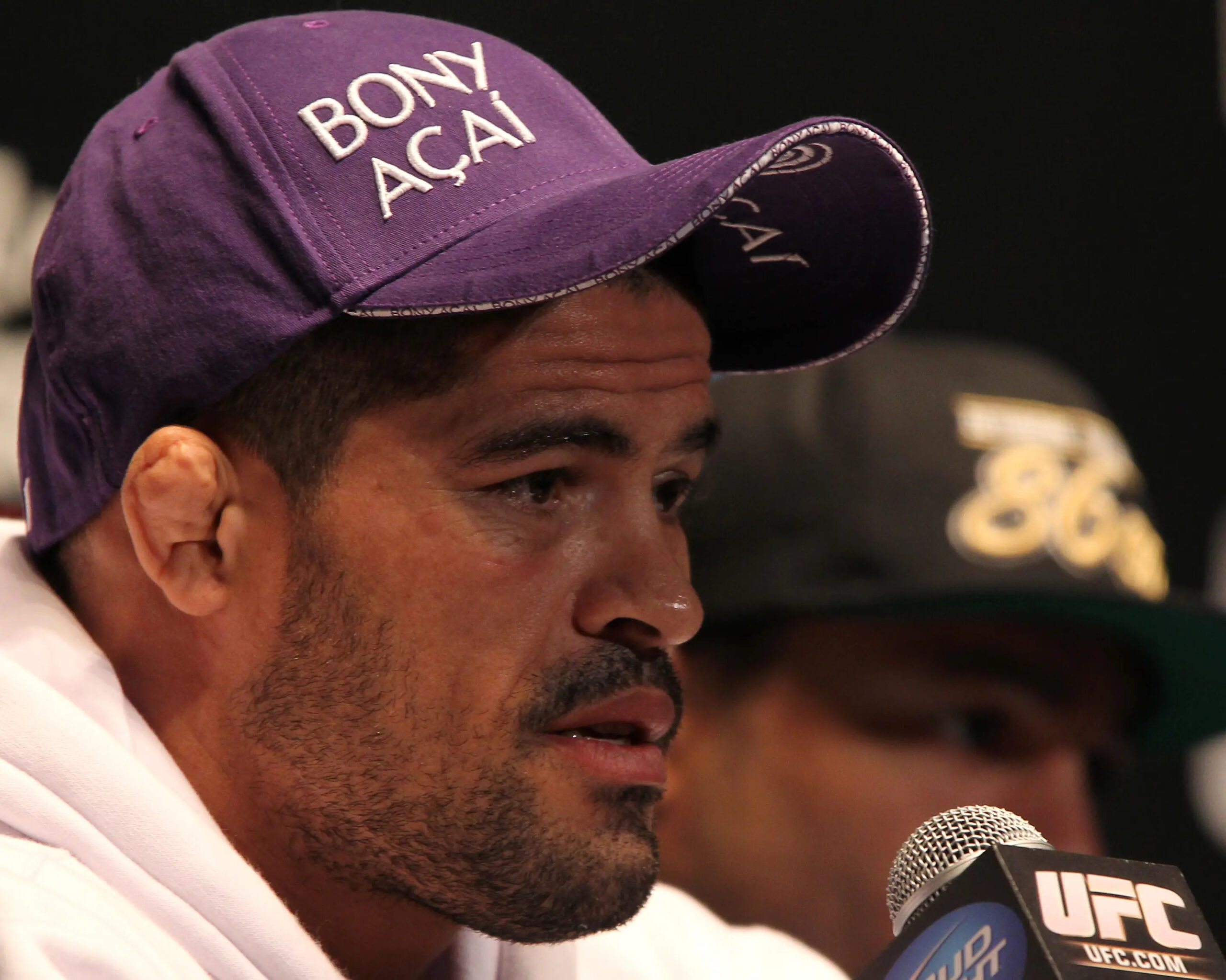
Rousimar Palhares got himself kicked out of two of MMA’s biggest promotions in less than two years.
(Josh Hedges via Getty Images)
Looking back on the immediate post-UFC chapter of Palhares’ career, Pierce couldn’t believe he was watching history repeat itself. Especially because the other most glaringly blatant controversy surrounding Palahres hadn’t changed: Performance-enhancing drug (PED) use.
Advertisement
Advertisement
Advertisement
Advertisement
That’s how intense the submission issue became around Palhares — or how minimally PEDs were a concern before the United States Anti-Doping Agency started working with the UFC in 2015.
“I don’t understand some of these promotions’ thought process on bringing in this guy who’s a known drug user, a known guy to hold onto submissions, specifically arguably the most dangerous submission possible,” Pierce says. “You can screw up the way somebody walks for the rest of their life, essentially. I don’t understand why someone would want to bring him into their fold and a part of their brand when he has those things on his résumé. And I know he did the same s*** to Jake, and I remember Jake smacking him after the fight was over — which, the guy had it coming. He really did. He was being an a**hole.
“Even after our fight, there was a bunch of media coverage about him doing what he did and someone actually interviewed Murillo Bustamante, who was his old coach at Brazilian Top Team, and he told the story about how he had to kick Palhares out of the gym because he was doing the same s*** to his teammates. These were people he trained with. They were what you would assume were friends or buddies that he was training with, not just like some random people that showed up to the gym that he didn’t care about. So I don’t know if it was a combination of him being too stupid or what his motivations were, or lack thereof. It doesn’t matter. There’s no reason for that.”
Palhares’ other test failure came in the UFC for a bout against Hector Lombard in 2012. It was never made public which substance Palhares popped for. Pick your poison and take a guess, says Davis.
I [didn’t] want to be one of these guys that has a permanent injury or some sort of cognitive disability at the end of this. I [wanted] to be able to get in here, do what I want to do, and get out and have a good, fun quality of life afterward for my kids, my kids’ kids. That was always the goal. I think I’ve succeeded with most of that — with the exception of Palhares.
“He was a PED junkie,” says Palhares’ longtime manager, bluntly. “OK, he did take a lot of s***.
Advertisement
Advertisement
Advertisement
Advertisement
“But he’s a unique human being — his build, the strength and where he comes from. Another thing that people don’t understand is he was a rural worker in Brazil, right? Now, when you think about working on a farm here in the States, you’re thinking about machinery and tractors. Where he came from, you’re talking about axes and sickles and hoes and real, real physical labor. It’s way, way different.
“When people talk about him coming from a rural background, they have no perspective of what that really means. That’s like maybe the late 1800 U.S. rural background. That’s the comparison.”
For someone who was as good at their specialty as Palhares was, it made the slope even slipperier, especially after he was cut from WSOF for the Shields incident. Back at middleweight and unleashed on MMA’s global regional scene, Palhares visibly and swiftly gained more muscle than ever before.
“I fought the guy fully on juice, and nobody talks about it,” says Lombard, 47, who ironically failed a drug test of his own for anabolic steroids three fights after he fought Palhares. “He was juiced to the max, to the gills, and then he got suspended. Have you seen the guy? How he looks now? He’s like twice as big. He’s huge.
Advertisement
Advertisement
Advertisement
Advertisement
“It wasn’t a surprise [after our fight]. But man, I just kind of worry about him because the way this guy looks, it’s like he’s using any kind of steroid possible. It’s not healthy.
“I think the guy is not well mentally. Honestly, I think the guy has some missing screws up there. You can see it today. You can see, like, ‘Bro, what are you doing? Like, look at you.'”
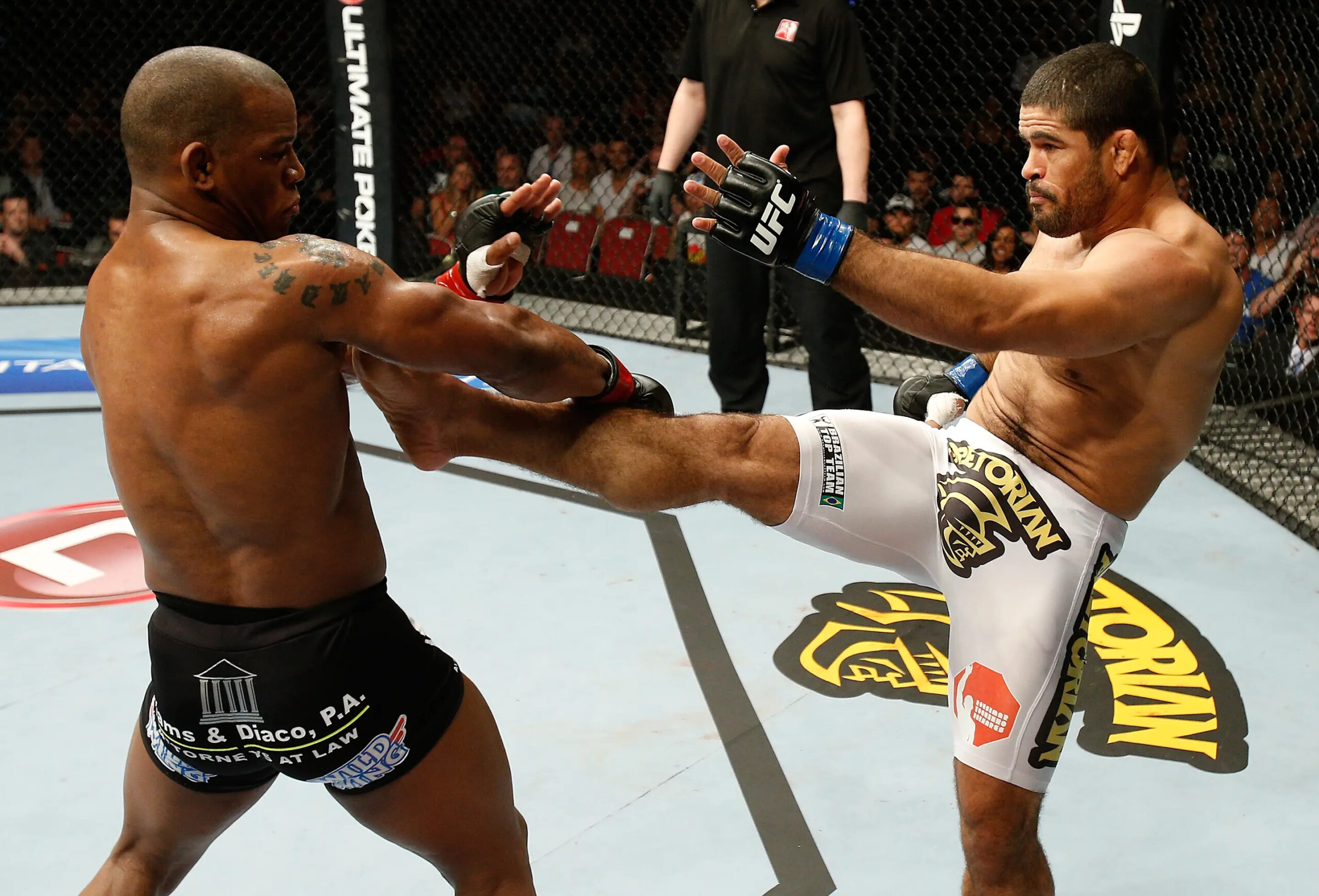
Dec. 15, 2012: Rousimar Palhares kicks Hector Lombard during their middleweight UFC fight. Palhares tested positive for PED use after the bout.
(Josh Hedges via Getty Images)
Former Strikeforce champion and one-time UFC title challenger Nate Marquardt was the first to deal with Palhares in 2010, after his controversial antics initially arose on the biggest stage.
Earlier that year, the Brazilian had beaten Thomas Drwal in 45 seconds in just his fifth UFC bout, a result that led to one of Palhares’ two UFC suspensions — 90 days on the shelf for, of course, holding onto the finishing heel hook too long, ultimately causing a “slow and weird crack” in Drwal’s ankle.
Advertisement
Advertisement
Advertisement
Advertisement
In preparation for the fight, Drwal had the same thought as the rest: Avoid the ground, and whatever you do, don’t throw any kicks.
“What did I do in the first round? I kicked and slipped. Game over,” Drwal, 43, says today.
A 41-fight veteran at the time, Marquardt saw the Drwal result and was even more motivated not to get caught. He was a talented grappler in his own right and only ever lost by submission once, which was a guillotine. Marquardt was well-equipped for the task and utilized, as he describes, basic defense to avoid any leg locks. He became the first fighter to stop Palhares with strikes, and fourth overall to beat him.
“Fighting him was definitely an experience,” Marquardt says. “I remember at the weigh-ins looking at him — he was a physical specimen. I remember looking down at his calf muscles, and he looked like a cartoon drawing, like a superhero. He just had these giant calf muscles. And I was like, ‘Wow. OK, this guy’s built. He is short and stocky, but man, he is a ball of muscle.’”
The American veteran’s fight IQ paid off when he and Palhares got into their first entanglement. Marquardt made his escape, and Palhares oddly appeared to speak to the referee about something before eating a decisive dose of Marquardt’s mitts. It was only later revealed that Palhares tried to communicate that Marquardt had illegally greased his legs. How else could someone escape this legendary hold? Cheating, of course — at least in theory.
“I’m sure my legs were slippery — I was sweaty,” Marquardt, 46, says with a shrug.
“Nothing like [how Palhares acted] had really ever happened [to me] in a fight.”
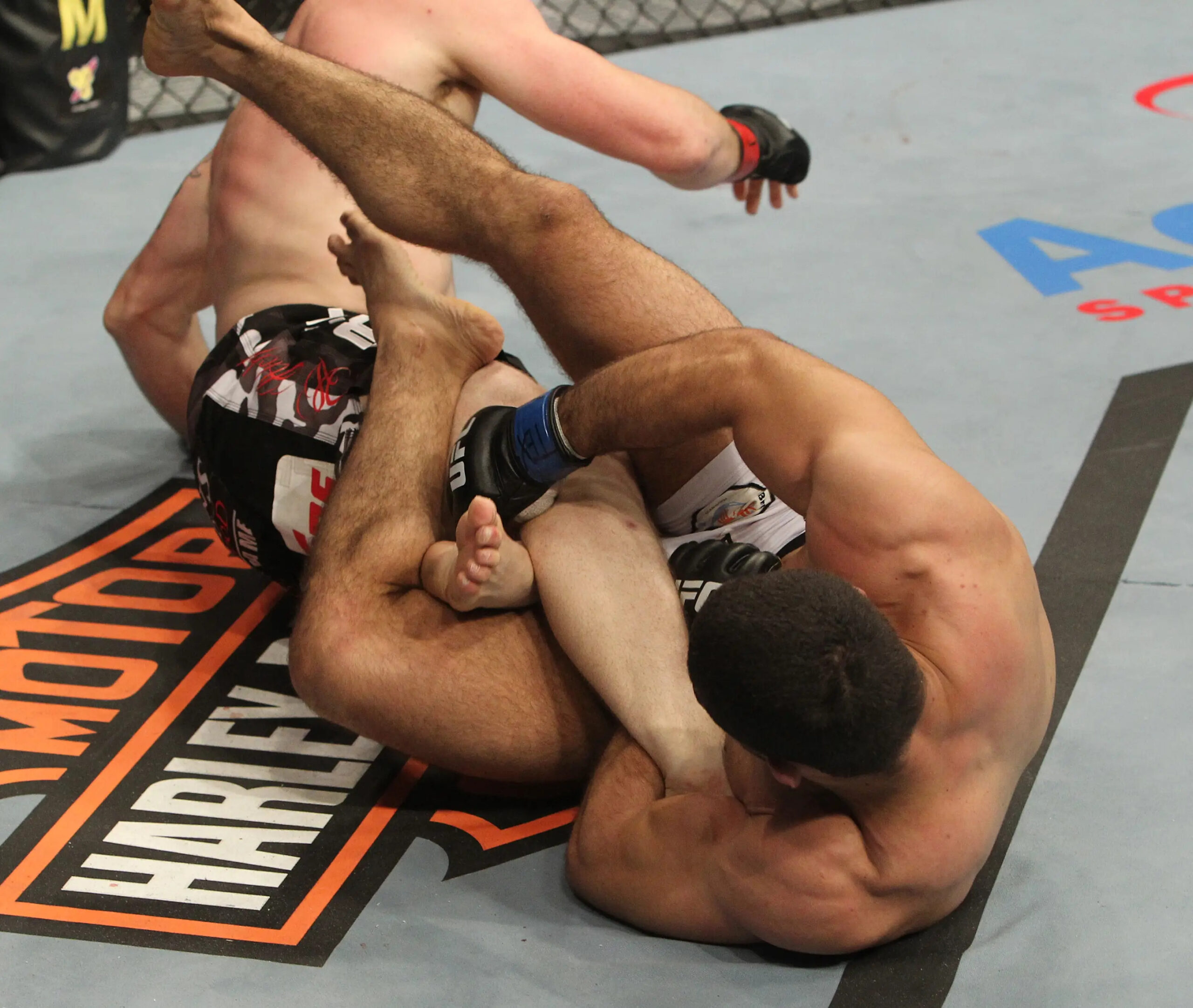
Sept. 15, 2010: Rousimar Palhares attempts a leg lock against Nate Marquardt at UFC Fight Night event at the Frank Irwin Center in Austin, Texas.
(Josh Hedges via Getty Images)
It was a bizarre scene, especially at a time when instant replay wasn’t being utilized to review fouls in MMA. The UFC commentary team highlighted the sequence, but didn’t know what to make of it as Palhares appeared to simply stop mid-fight. Davis recalls the awkward ending to the fight along with the allegations. In his own words, Marquardt’s leg was shaved smooth, “like a baby’s leg,” but “dry as a bone.”
“Every time Rousimar would go for something that wouldn’t work, he’d come up and say the guy was oiled,” Davis says.
As rare as greasing accusations are in MMA, it wasn’t the strangest part of the fight for Marquardt.
“I told you about his calf muscles, and he was just like a ball of muscle,” Marquardt says. “That kind of makes you suspect a little bit, but also this is one thing: When I fought him in Texas, we had to go do our urine test, our piss test after the fight. They give me a cup and they’re like, ‘OK, go in the bathroom.’ I’m going into the stall and I realized somebody’s in there. So I wait — and then all of a sudden, out comes Rousimar Palhares with Murillo Bustamante, his trainer.
“They were both in the same stall, and he’s doing his pee test. So I’m like, ‘Ah, OK.’ So apparently, you know, they don’t really monitor who pees or whose pee is going into the cup. You can have your training partner or coach help you out on that.
“I don’t know that he was doing anything in my fight, but you could expect, or you could kind of guess that something like that might be happening.”
Davis says he’s never heard the bathroom story before, but from what he knows of Marquardt, he figures if that’s what the former Strikeforce champion saw, he believes it. Marquardt doesn’t seem like a guy to make up lies, says Davis, especially for a fight he won relatively easily.
“I always looked at him and thought maybe there’s something a little off about him,” Marquardt says of his one-time opponent. “Maybe he’s a little bit troubled or something. I don’t know why, because he never seemed like a super angry guy or something. I think, yeah, he’s just a little off.
“I would hate to train with someone like that. That would be a nightmare. I would not want someone like that as my training partner. But I think since I’ve seen that he has a school, and I saw a few pictures on social media and it looks like he’s happy and stuff. So I hope he’s doing well, to be honest.”
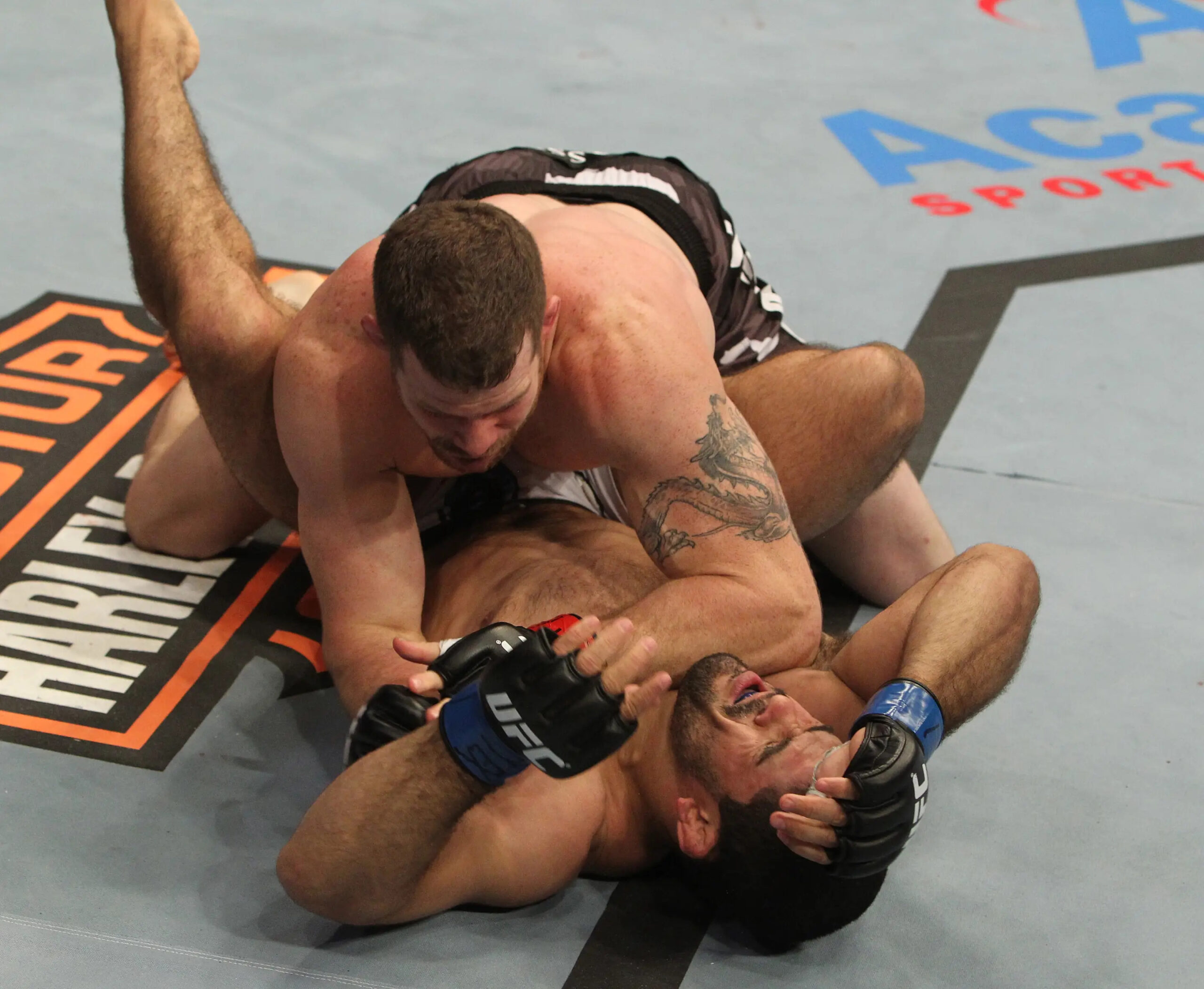
Sept. 15, 2010: Nate Marquardt (top) defeats Rousimar Palhares by TKO at a UFC Fight Night in Austin, Texas.
(Josh Hedges via Getty Images)
Even though I watched Palhares’ career play out in real time, hearing all these perspectives made the memories feel like a fever dream. It was too absurd. Palhares was like the Sasquatch of MMA. A mere figment of your imagination, lurking in the background of a landscape, misconstrued as a shadow.
The Brazilian did next to no English media throughout the entirety of his mainstream career, if any at all outside of UFC promotional material. He was the definition of: Arrive, destroy, leave.
As I spoke to more and more past opponents, it built up a terror of Palhares as a man in general. If I interviewed him, was he bound to snap at any moment? Could he jump through my computer screen and rip my leg off somehow?
Instead, Palhares was the opposite. And he had plenty to say.
“I think that I let people interpret [my reputation] a bit, I let myself be more misunderstood, in terms of what people said,” explains Palhares, speaking through an interpreter. “[People would say,] ‘But the guy took a long time to let go and stuff.’ No. It wasn’t that I took too long to let go — it was because sometimes I was afraid of hurting my opponent, and sometimes I was afraid of being misunderstood. This happened several times I’ve lost. I’m not belittling any athlete, but I’ve lost several fights because of this.
“I had nothing wrong with me. The wrong thing was that people couldn’t understand the speed, the explosion, the reasoning that I had to be able to do this.”
To best understand Palhares, he says, you have to go back to the beginning.
As a child, “Toquinho” lived out in the countryside of Dores do Indaiá with his father and mother and 12 siblings. He was about eight years old when he saw a movie that featured martial arts in some capacity. He can’t remember what the movie was, but it was at that moment that his life changed forever.
It wasn’t that I took too long to let go — it was because sometimes I was afraid of hurting my opponent, and sometimes I was afraid of being misunderstood. This happened several times I’ve lost. I’m not belittling any athlete, but I’ve lost several fights because of this.
After seeing this film, he believed with zero doubts that he was meant to be a fighter. There was a gym down the road from where Palhares lived, and as soon as he could, he began accompanying the local boys to train and attend church. First it was capoeira, karate, then jiu-jitsu — the latter of which took over Palhares’ primary interest after watching Royce Gracie succeed at the onset of the UFC.
But Gracie never pulled off a single leg-lock submission in his storied MMA career, so what was it about those lower-limb techniques?
“As I see it, it was a part that I saw very early on — the deficiency that people had in working with this part and with this game,” Palhares says. “Every time I moved my lower limbs, I saw that I had an advantage, but I didn’t say anything.
“When the teacher showed a position, the guys did it 10 times; I did it at least 10,000 times. And the next day, again, again, again, again, until my body believed I was born that way.”
In present-day MMA, the art of the leg-lock submission is almost a dead concept. The proof in that pudding is visible with one glance at Palhares’ post-WSOF career.
Fighters become open to punches with their heads fully exposed in pursuit of such an extended position — and for Palhares, it was his sole game from his 2004 pro debut onward, without any real evolution. That mastery carried him a long way, but he lost his last five fights, four of which were first-round knockouts. The most recent came in March 2024.
It’s still not that cut and dry, though. Is the technique becoming outdated, or is Palhares just a 45-year-old who’s competed for nearly his entire life? The man himself still swears by his ways.
“I’ll tell you the truth: Nothing scares me because I’ve been to so many places,” he says. “I think God showed me the way early on for this style of fighting, which is with the lower limbs.
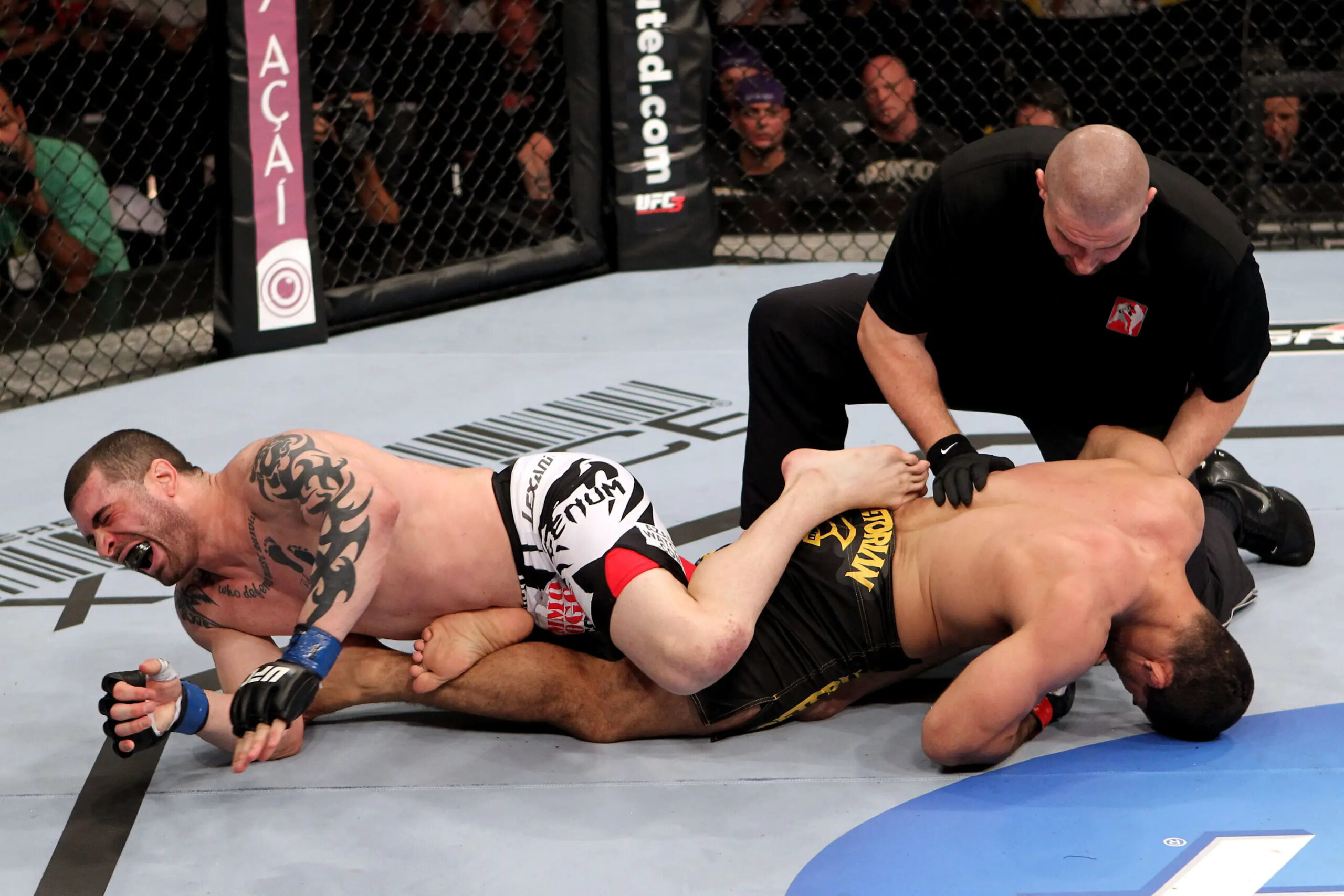
Jan. 14, 2012 in: Referee Leon Roberts (top) tries to stop as Rousimar Palhares after a leg-lock submission of Mike Massenzio at a UFC event in Rio de Janeiro, Brazil.
(Josh Hedges via Getty Images)
“There’s nothing more difficult than the lower limb game, because it’s a game that nobody’s used to doing. Everyone usually works where they can see, right? Jiu-jitsu isn’t just about vision. Jiu-jitsu is about sensitivity. It’s [about] vision for those at one level, but when you go to another level, it’s just sensitivity. You feel everything. Then you feel your opponent’s weaknesses when you put your hand on them.”
Palhares laid waste to his opponents on the Brazilian regional scene early on, going 7-2 before he caught the attention of the UFC in 2008.
Winning was everything to Palhares, he says. Once the cage door closed and the first bell sounded, it was almost like the need to win forced him to revert into a more primal nature. Do or die. His art of lower limb entanglements essentially made him a Venus flytrap to the opponents in front of him. In his mind, once they got got, it was a wrap — no matter what. Therefore, there wasn’t a reason to hold onto a submission beyond the tap, he says, other than making it definitive that Palhares was the victor of the matchup.
“I think that’s why sometimes there was this doubt in people’s minds, because [they’d say], ‘The bell rang and he didn’t release it,’ and so on,” Palhares says. “But it’s not that I didn’t release it because I didn’t want to, or do it out of spite. No, no, nothing like that. Imagine that? What was I going to do? I was going to win. I was going to hurt someone who was already in training, already caught? I’d get nothing out of it. Understand? So my business was to win. I had to win.
“I give everything in here, every day. Every single day. If the position didn’t even fit properly [but] they were already kind of hurting, that wasn’t normal for me because I felt that it [wasn’t the perfect] position. It was already finished, [but] I had to feel in myself that the position was already perfect. As long as I felt that [it wasn’t perfect], then I wouldn’t let go. I think that’s what made me do it — I created a block at that moment. I wanted to make people believe that [my technique] was incredible. I think it has to be perfect. As long as it’s not perfect, it’s not right.”
The Marquardt fight is an interesting one for Palhares to reflect on. It was the first controversial fight of his career where the result was a loss.
As long as I felt that [it wasn’t perfect], then I wouldn’t let go. I think that’s what made me do it — I created a block at that moment. I wanted to make people believe that [my technique] was incredible. I think it has to be perfect. As long as it’s not perfect, it’s not right.”
Although Palhares’ bizarre greasing allegations are the story most remember today, it’s not even a point he mentions 15 years later. “Toquinho” saw everything from a much different angle. The situation with Drwal in his prior fight had put a shortened leash on Palhares, he says, inching its way toward where things inevitably reached with athletic commissions during the WSOF days and beyond. So against Marquardt, he attempted to make a more conscious effort not to prolong a submission after a potential tap — and for that reason, he believes, it cost him the win, not only in the Marquardt fight, but in others as well.
“[Marquardt] turned into the leg lock, his leg stretched out, he was out of it and he was the only one screaming,” Palhares says. Because of his previous actions against Drwal, Palhares says, he was warned to release his hold immediately upon a scream or tap, as one is supposed to do. With Marquardt, he claims to have heard a shout from his opponent during the escape, which prompted him to look at the referee in the visible confusion spectators watched unfold in the cage.
“That was unfair, very unfair to me, because I went in for the finish, I took it down, I swept — beautiful. I did everything I wanted to do,” Palhares says. “When I went for the leg, I was careful. I didn’t even go with all the violence I like to.”
While fear of Palhares’ game was rightfully a big talking point for anyone up against him at the height of his powers, the jiu-jitsu wizard argues that because of the microscope he ultimately put himself under, he was actually battling a fear of his own. Not fear of his opponents, though.
To put it bluntly, Palhares felt he showed mercy.
“If I’d wanted to, I could have ended his career,” Palhares says of Marquardt. “I didn’t, you know? But it’s a pain I still have today, can you believe it? That’s why I carry this pain. Because I know — but he also knows — the ref said, ‘The guy shouts or hits you, you have to let him go because [the athletic commissions are] already watching you.’ So I did. I already fought with a bit of fear.”
Palhares’ eventual UFC release didn’t come as a surprise after his collection of controversies inside and outside of the Octagon. Yet as far as he’s concerned, he was just doing what he was supposed to do. Palhares knew the American audience loved to watch him for one reason or another. In the jiu-jitsu community, he became more popular outside of his home country, performing more seminars stateside than in Brazil. That made his UFC exile all the more upsetting, he says, knowing he had an uphill battle to climb going forward if he wanted to stay in North America.
He’d reached the biggest stage in the world in the sport he loved more than life itself. To say the sadness was intense in the immediate aftermath of his release would be putting it mildly.
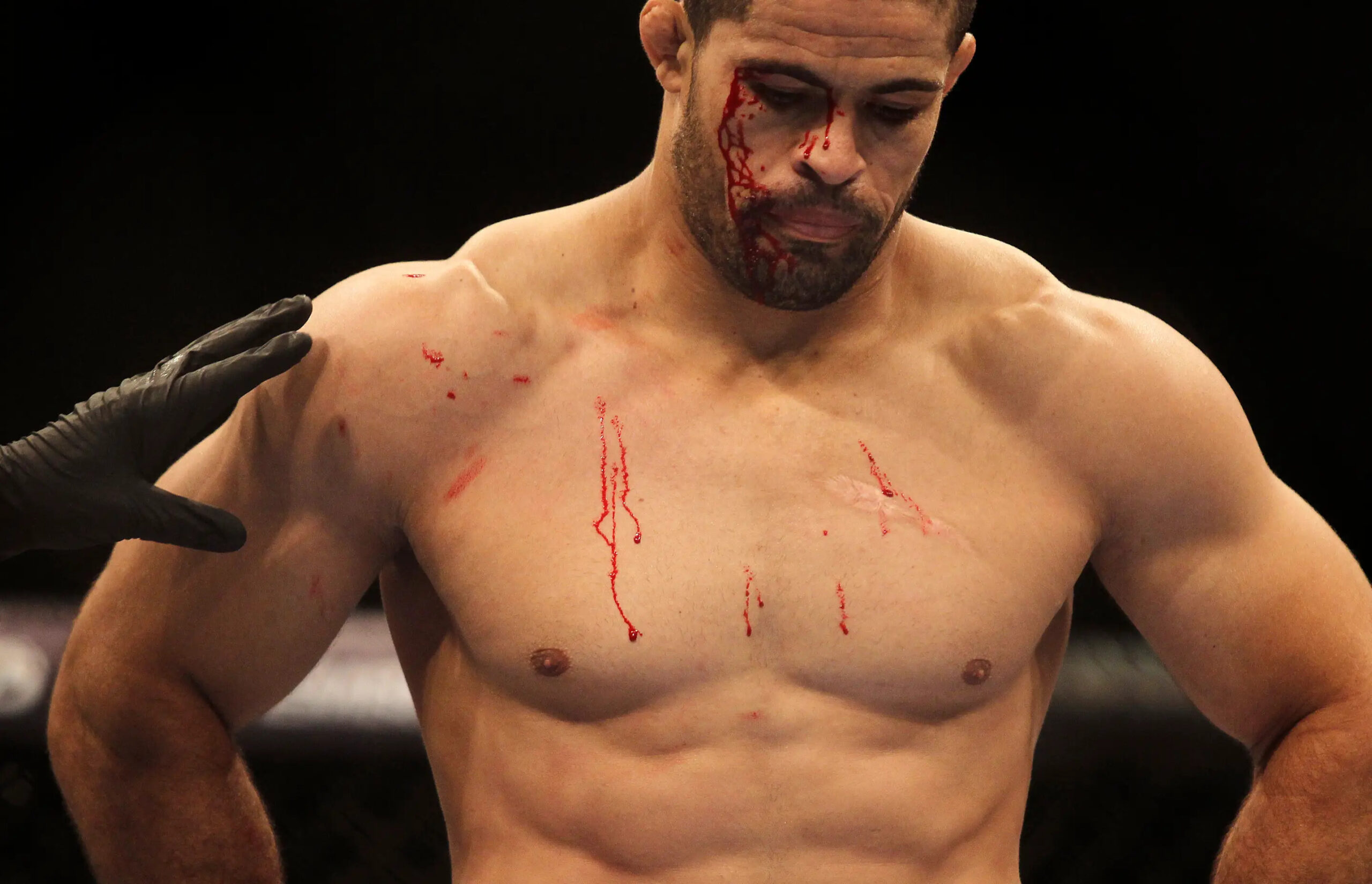
Rousimar Palhares was ultimately released from the UFC in 2013 after one too many controversies.
(REUTERS / Reuters)
Palhares would go back in time and change things if he could, he says today. Though it’s safe to assume his ideal version of history would have led to the same result. In that parallel universe, his ferocity wouldn’t have wavered, he says, but instead intensified — and we would’ve seen even more of those violent submissions, not fewer.
“I’ll tell you the truth, honestly, from the bottom of my heart,” he says. “[My opponents] know the leg lock is not going to come off, so they kept looking for loopholes. That makes me very sad, but they know who they’re fighting.
“I go through the pain I’m going through today because I didn’t do what I should have done. Because we weren’t fighting grappling, we were fighting MMA. Which is, the winner is whoever causes the most damage to the other and makes the other give up. So I would have, yes … been more of myself.
“That’s the regret I have.”
It makes sense for past opponents to draw the types of conclusions about Palhares that many have over the years. But even Davis, someone who was close to the submission ace, has mixed feelings.
Not even Palhares’ old coach, Bustamante, is on good terms with his old charge anymore.
“That’s a monster. That’s a mixture between a man and a gorilla. I’ve never seen somebody so f***ing strong in my life,” Davis says. “He’s a good person, but he was surrounded with a lot of bulls***.
“That was difficult. Very, very f***ing difficult.”
An argument could be made that Palhares was too much of a fighter for MMA. He embodied a “to the death” spirit best fit for a gladiatorial coliseum. For better or worse, he was a true one-of-one.
In 2025, at age 45, he has yet to retire from competition. If his career ended today, Palhares says, he wouldn’t be satisfied. Regardless of what’s happened in the past, he plans to continue onward.
“In my life, I think the only thing that I would consider a loss and a defeat for me is if I no longer needed a mat to train on,” he says. “I think then my life would have no meaning. I think I’d kill myself. I think the love I have for being a jiu-jitsu practitioner is too great. It’s incredible. It’s inexplicable.”

